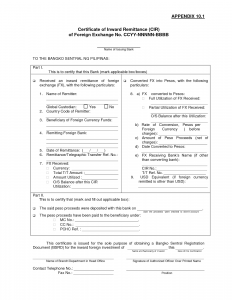In this blog post, Dhiren Sehgal, who is currently pursuing a Diploma in Entrepreneurship Administration and Business Laws from NUJS, Kolkata, writes about the concept of FIRC and highlights it’s importance in the economic world.
What is FIRC?
FIRC, also was known as Foreign Inward Remittance Certificate is a documented proof or a testimonial document for all the payments or remittances which are entering India from foreign countries. This document or certificate for that matter can be used as a proof by an individual of payment which has been received by the individual, which is in a foreign currency and is coming from outside the country. This document is regarded or treated as a document of an evidentiary value by most of the statutory bodies, as a means to confirm the validation of the transaction of foreign currency received by the beneficiary. When the money or payment is received from a foreign country, the amount payable is credited to the account of the person receiving the payment, by a body such as banks which have been authorized by the Reserve Bank of India for making that transaction. This sort of a transaction can’t take place when the beneficiary doesn’t have an authorized bank account; this authorization is to be done by the Reserve Bank of India.
The money you’ll be receiving as a remittance will be converted into Indian currency and then transferred into you authorized bank account. The banks arrange for Foreign Inward Remittance Certificate, which contains the following details- original currency, equivalent Indian currency, transferor bank details, etc. According to the procedure, this certificate comes to your account address within 15 days from the date of funds being credited to your account.
A Foreign Inward Remittance Certificate is deemed as a very important document of proof as it serves a lot of purposes. For example, if there are some numbers of shares which have been issued in the name of a beneficiary and the company which has issued the shares exists outside the country, then the Foreign Inward Remittance Certificate acts as an evidentiary proof of the money received and also validates the transaction made. The Foreign Inward Remittance Certificate also acts as a testimony in those cases where an Indian resident transfers or sells his shares to a person who’s a non-resident Indian or some foreign entity. Then, the Foreign Inward Remittance Certificate can be used as something that will testify that the share purchase consideration has been received by the resident seller in the case. It’s an extremely crucial document which is submitted to the Director General of Foreign Trade in cases of export promotion capital goods and advanced licensing requirements.
In cases where the services are exported, there is no service tax levied on those services which have been laid down in the rules of exporting of services. Also, in similar sort of cases, the Foreign Inward Remittance Certificate acts as an important and indispensable proof of the export of services being carried on and the remittances being directed into the country by exporting the services and the remittances received in lieu of carrying these trading of services. There are different subtle elements which are incorporated into FIRC. FIRC conveys the recipient’s name, method of installment i.e. whether the foreign cash currency has been deposited to the account of the recipient or money has been given to him, address and name of remitter, Check/DD/TT no., accurate measure of foreign currency, measure of cash when changed into the currency of the country of recipient, name of the individual in whose support the sum has been sent, reason for the receipt of remittance and rate of trade which is currently prevalent.
Details contained in FIRC
A Foreign Inward Remittance Certificate contains the following details-
- Beneficiary’s name
- Whether the money has been paid by cash or by crediting the account of the beneficiary
- Name and the address of the person being remitted
- Name and address of the authorized bank remitting the amount
- DD / TT No / Cheque No
- The foreign direct investment amount in the foreign currency
- The equivalent amount in rupee (should be in figures as well as words)
- The name of the person in who’s favor the amount has been remitted
- The prevalent exchange rate which has been applied
- What the purpose of the respective remittance is as stated by the beneficiary
After these details have been filled out, the Foreign Inward Remittance Certificate is then signed by the authorized signatory of the authorized designated bank and is further countersigned by one more person. According to the procedure, the Foreign Inward Remittance Certificate has to be issued to the address of the account holder, which normally has to be within a period of not more than fifteen days from the date on which the funds which were to be remitted were credited to the beneficiary’s account in the authorized bank. A Foreign Inward Remittance Certificate is very important to document and if lost, then getting a duplicate certificate issued is an extremely complicated and time-consuming procedure.
There exists confusion as to which bank is authorized and has the jurisdiction to issue a Foreign Inward Remittance Certificate in cases where the inward remittance has been transferred into the beneficiary’s account through more than one bank account. However, as per the clarifications sent out by the RBI notifications and circulars as well as the provisions under FEMA, the first that receives the inward remittance in convertible foreign currency must issue the Foreign Inward Remittance Certificate first as it would have the requisite details of the overseas bank which have remitted the foreign exchange.
Conclusion
Therefore, as it has been explained above, the Foreign Inward Remittance Certificate is of great importance when it comes to remittances received from banks which are overseas and not in India. Thus, it is indispensable and necessary that the beneficiaries make it a point and priority to follow up with the banks and get their Foreign Inward Remittance Certificate issued as soon as possible after the inward remittance has been credited. Also, a specific detail and attention needs to be paid for the purpose of foreign direct investment, as any error in the mentioning of this has serious implications and consequences when it comes to remittance, its usage, and accounting of the same.
 Serato DJ Crack 2025Serato DJ PRO Crack
Serato DJ Crack 2025Serato DJ PRO Crack














 Allow notifications
Allow notifications




Thanks for explaining significance of FIRC. My question is if Fores has come to companies account for software services export. Do we need to further share this information or certificate with RBI or any other body. any limit of min or max limit for inward forex payment ?
What is the difference between BRC and FIRC?